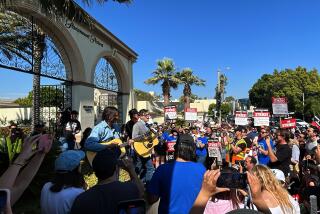Britain Is Changing Its Tune on Street Musicians
- Share via
LONDON — Street buskers have long lived on the fringes of society. As minstrel, troubadour or hobo, the traveling musician has been seen as a creative troublemaker with an instrument on his back.
But in a country where it’s not uncommon to see talented classical string quartets, opera singers or rock guitarists performing for nothing more than a handful of coins, street musicians’ contributions to society are gradually being recognized with a fresh eye.
Everyone from government officials to social service workers is coming to view buskers as a means of improving city life.
“They say we’re the next-oldest profession after prostitution,” said Tylluan O’Sinend, head of the Buskers’ Union, a collective of street musicians raising awareness of homelessness--and raising money--through their art.
A formerly homeless busker in Bath in southwest England, O’Sinend is at work on the group’s second attempt to earn money for the homeless through busking. Last year’s No Fixed Abode project provided grant money to homeless street musicians so they could make CDs of their music in a professional studio. They sell the CDs and give a portion of the profits back to the Buskers’ Union to help other homeless musicians make recordings.
“We don’t want to throw money at the problem,” O’Sinend said. “This way we are helping ourselves, instead of just getting handouts.”
Now she’s recruiting buskers nationwide to record tracks for a “Best of the Buskers” CD, due out this winter. Sales of the compilation, featuring only original works, will raise money for organizations that deal with homelessness.
Playing on the image of the free-spirited wandering musician, O’Sinend will take her buskers on a nationwide benefit concert tour.
Aside from raising money for a good cause, O’Sinend sees music as a way for people on the street to boost their self-esteem. Others see street entertainment as simply a pleasant contribution to public life.
And then there’s the historical perspective, which puts buskers in less than illustrious company.
“Street entertaining is one of those features that tend to crop up, like usury, prostitution, crime and poverty, wherever settlements develop into cities,” says “The Buskers: A History of Street Entertainment,” a 1981 book by David Cohen and Ben Greenwood.
Busking has been allowed on the streets of London for ages; the first record of a street performance at Covent Garden dates to 1622. But it has been illegal in the city’s subway stations, which are preferred by many musicians because they are dry and have good acoustics. But a change this spring in the bylaws of the London Underground agency allows management to license buskers to perform in stations.
“We’ve changed the bylaws to bring them into the 21st century,” said Donal O’Reilly of London Underground. “Customer surveys show that people like to see high-quality busking in the stations, but not in the trains.”
The six-month pilot program will begin late this year or early next year. After auditioning the musicians, the Underground will allow a select number to buy licenses to perform in eight central stations.
Bill Purdue, a professor of popular culture at Britain’s Open University, criticized the program. “What we’re witnessing now is authority trying to regulate something that’s grown organically over the centuries,” he said.
For now, however, busking underground is still illegal. Musicians play anyway--some make as much as $35 an hour--but they face possible fines or the risk of being booted by police.
Although the licensing plan recognizes the contributions buskers make to an otherwise unpleasant environment--the stations are stuffy, crowded, dirty and moldy--many of the musicians are skeptical of the program.
“There’s still going to be the same old problems,” said Jean-Pierre Lampe, who’s been playing the double bass in stations for six years and has gone to jail for not paying the fines he has incurred.
“The Underground staff will choose who gets to play down here,” he said. “If there’s one person upstairs who doesn’t like us, we won’t be able to play. So they’ll still have the same amount of power as they have now.”
Buskers add a festive ambience to urban streets. A stroll through Covent Garden--an area filled with musicians, clowns, jugglers and mimes--shows just how much performance art creates a sense of vitality on city streets.
In their efforts to transform Trafalgar Square in central London from a place people pass through to a place where people hang out, city officials have solicited applications from buskers.
“Our plan is to make Trafalgar Square a more sociable space, to give it a piazza-style atmosphere,” said Helen Hall-Wright of the Greater London Authority.
Mayor Ken Livingstone wants the buskers at Trafalgar Square to represent London’s ethnic and cultural diversity, Hall-Wright said.
Street performance may benefit public life. But it remains in essence a commercial operation, where people pay for a service they enjoy.
Matt Jones, who has been playing acoustic guitar and singing in the Oxford Circus Tube station for 10 years, knows how to get a smile--and a load of coins: He belts out the Beatles’ “Penny Lane.”
More to Read
Sign up for Essential California
The most important California stories and recommendations in your inbox every morning.
You may occasionally receive promotional content from the Los Angeles Times.













